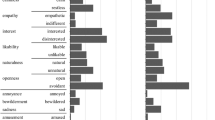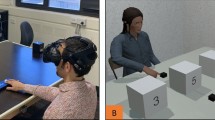Abstract
Hypotheses and assumptions on the intimacy regulating and the monitoring function of gaze were tested in three successive experiments. In a 2 (sex of the dyad) × 6 (order of the intimacy levels) × 3 (questions' intimacy level) factorial design 144 subjects were interviewed by a confederate who was either constantly looking into their eyes (experiment I), was constantly avoiding mutual gaze (experiment II) or showed varying looking behavior (experiment III). The data clearly revealed that the compensation hypothesis predicting an inverse relationship between gaze and topic intimacy has to be rejected. Intimacy regulation through gaze functions more via adaptation processes. Adaptation can also account for differences in gaze dependent upon the partner's looking behavior. The sequence hypothesis which predicted decreasing gaze with increasing predictability of the partner's behavior was confirmed.
It follows from these data that looking behavior has an internal structure with information receiving (regarding the partner's attentiveness and the ease of monitoring the interaction, monitoring function) more important in an encounter than information sending (communicative function); and—at least in the type of situation chosen—reactions towards situational conditions are primarily performed via adaptation processes.
Similar content being viewed by others
References
Abele, A., Spiller, H. Intimität des Themas und Blickverhalten. University of Bielefeld: Unpublished manuscript, 1980.
Abele, A. Acquaintance and visual behavior between two interactants. Their communicative function for the impression formation of an observer.European Journal of Social Psychology, 1981,II, 409–425.
Aiello, J.A. Visual interaction at extended distances.Personality and Social Psychology Bulletin, 1977, Vol.3(1, 83–86.
Aiello, J.A. A test of equilibrium theory: Visual interaction in relation to orientation, distance and sex of interactants.Psychonomic Science, 1972,27, 335–336.
Anderson, D. Eye contact, topic intimacy and equilibrium theory.The Journal of Social Psychology, 1976,100, 313–314.
Argyle, M., Cook, M.Gaze and mutual gaze. Cambridge: University Press, 1976.
Argyle, M., Dean, J. Eye contact, distance and affiliation.Sociometry, 1965,28, 289–304.
Argyle, M., Ingham, R. Gaze, mutual gaze and proximity.Semiotica, 1972,6, 32–49.
Coutts, L., Schneider, F. Visual behavior in an unfocused interaction as a function of sex and distance.Journal of Experimental Social Psychology, 1975,11, 64–77.
Duncan, St. jr., Fiske, D.W.Face-to-Face interaction: Research, methods and theory. Hillsdale, N.J.: Lawrence Erlbaum Ass., 1977.
Ellsworth, P., Ross, L. Intimacy in response to direct gaze.Journal of Experimental Social Psychology 1975,11, 592–613.
Exline, R., Gray, G., Schuette, D. Visual behavior in a dyad as affected by interview content and sex of respondent.Journal of Personality and Social Psychology, 1965,1, 201–209.
Harper, R., Wiens, A., Matarazzo, J.Nonverbal communication: The state of the art. New York: Wiley, 1978.
Heslin, R., Patterson, M.Nonverbal behavior and social psychology. New York: Plenum Press, 1982.
Patterson, M.L. An arousal model of interpersonal intimacy.Psychological Review, 1976,83, 235–245.
Rubin, Z. Measurements of romantic love.Journal of Personality and Social Psychology 1970,16, 265–273.
Schulz, R. Barefoot, J. Non-verbal responses and affiliative conflict theory.British Journal of Social and Clinical Psychology, 1974,13, 237–243.
Sundstrom, E. A test of equilibrium theory: Effects of topic intimacy and proximity on verbal and nonverbal behavior in pairs of friends and strangers.Environmental Psychology and Nonverbal Behavior, 1978,3, 3–16.
Author information
Authors and Affiliations
Additional information
This research was supported by a grant from the University of Bielefeld 86/2754.
Rights and permissions
About this article
Cite this article
Abele, A. Functions of gaze in social interaction: Communication and monitoring. J Nonverbal Behav 10, 83–101 (1986). https://doi.org/10.1007/BF01000006
Issue Date:
DOI: https://doi.org/10.1007/BF01000006




